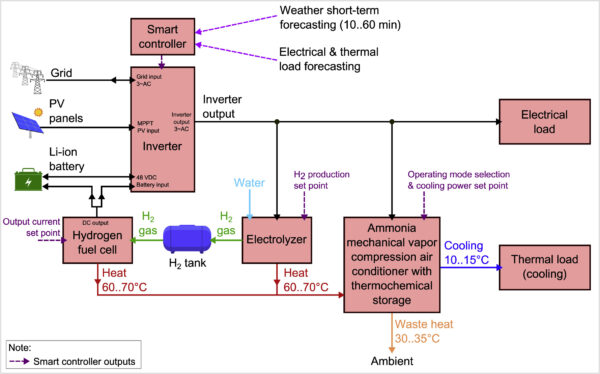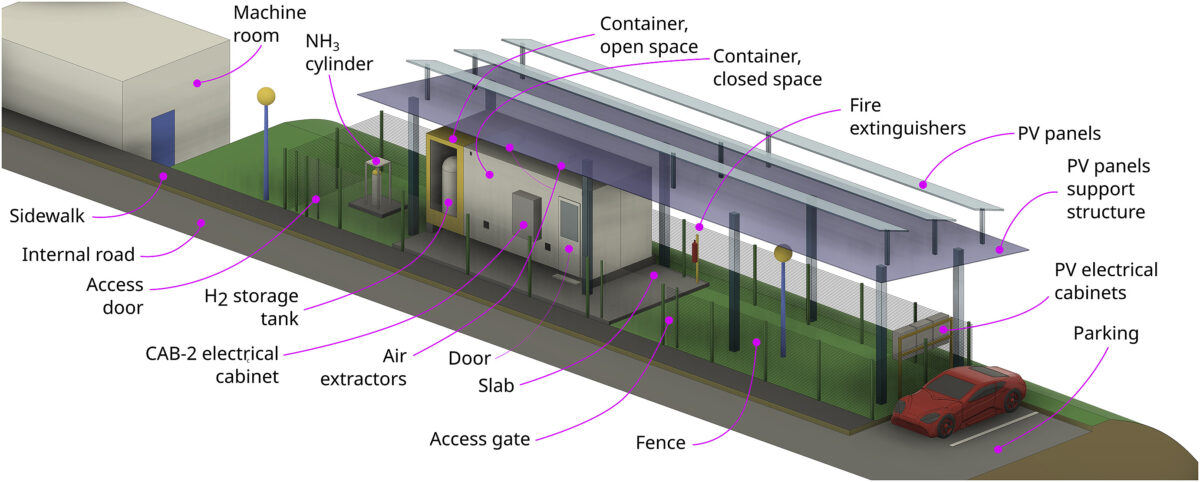The University of French Polynesia has developed a solar-powered microgrid supporting the generation of hydrogen that is, in turn, used to produce electricity and cooling.
The system couples a hydrogen generation chain consisting of an electrolyzer and a fuel cell with a thermochemical unit. The hydrogen chain is used as a storage unit, using electrolysis to split water into hydrogen (H2) and oxygen and then convert H2 back to electricity via a fuel cell. The thermochemical unit is designed to recover waste heat from the electrolyzer and fuel cell to enable deferred cooling production for air conditioning purposes.
“The RECIF installation comprises the following components: a hybrid inverter, PV panels, a Li-ion battery pack, a PEM electrolyzer for H2 production, an H2 storage tank, a PEM fuel cell for electricity production from stored H2, a controllable electrical load and a custom-made air conditioning system with a thermochemical unit for thermal energy storage and deferred cold production,” researcher Franco Ferrucci told pv magazine, noting that the components are installed in a 20-foot container.
As a thermochemical solid/gas pair, the system utilizes a barium chloride salt (BaCl2) reacting with ammonia (NH3), which in turn serves as the coolant fluid in the refrigeration circuit. “This pair has the advantage of being able to work with heating sources of relatively low temperature (55 C), making it compatible with PEM electrolyzers and fuel cells,” the researchers said.

Image: University of French Polynesia, International Journal of Hydrogen Energy, CC BY 4.0 DEED
The research group deployed the system in 2018 and ever since, concerns about the safety of the system have arisen. “The commissioning of such an installation was very challenging, mainly due to the lack of experience in the territory with this type of installation and an unclear regulatory context regarding safety systems and explosive atmospheres,” the scientists explained.
In order to address these safety issues, the group also developed a safety system that is intended to reduce explosion risks related to H2 and NH3 gases. In a small hydrogen installation, the greatest risk may materialize in the event of a hydrogen leak that cannot be detected within an improperly ventilated enclosure.
“Our installation has solar panels covering a surface of 23m2, and the protection system features 1000 V contactors that disconnect the panels when the safety system detects an accident condition, as one of the safety actions is to interrupt the production of renewable electricity,” Ferrucci said.
“In the case of a larger PV installation, it is not practical to disconnect the panels directly, as there is not a wide variety of high-voltage DC contactors on the market. In that case, the safety system would need to disconnect the inverter so that it cannot supply power to the rest of the installation. Additionally, there should be a physical distance between the PV electrical panel and the hydrogen installation,” he added.
Popular content
The safety system also includes an electrical cabinet that contains a safety programmable logic controller (PLC), which can disconnect the power flow. Another tool employed is a forced ventilation system with continuous air renewal and emergency ventilation modes, along with fire extinguishers and smoke detectors.
In addition, a set of relief values is installed in the H2 storage unit, and sensors can monitor the H2 levels at the fuel cell and the electrolyzer. Also, several transmitters can interrupt the power supply of the thermochemical unit when danger is identified. All the safety tools can be controlled and monitored via a supervisory control and data acquisition (SCADA) system and a safety instrumented system (SIS).
“In broad terms, the primary goal of the installation is twofold: to provide power to the electrical load and maintain a suitable level of thermal comfort inside the container in which components are installed,” said Ferucci, referring to the safety system.
The microgrid concept and the related safety system were presented in the study “Design and implementation of the safety system of a solar-driven smart micro-grid comprising hydrogen production for electricity & cooling co-generation,” published in the International Journal of Hydrogen Energy.
“The study establishes the reliability of the gas detection system, affirming its adherence to safety integrity level SIL-2 based on risk analysis and recommendations from the specialized inspection and certification company overseeing RECIF installation validation,” Ferrucci said. “The simulations conducted demonstrate that the safety system promptly detects and stops any leaks inside the container, effectively reducing the gas concentration to negligible levels.”
This content is protected by copyright and may not be reused. If you want to cooperate with us and would like to reuse some of our content, please contact: editors@pv-magazine.com.


By submitting this form you agree to pv magazine using your data for the purposes of publishing your comment.
Your personal data will only be disclosed or otherwise transmitted to third parties for the purposes of spam filtering or if this is necessary for technical maintenance of the website. Any other transfer to third parties will not take place unless this is justified on the basis of applicable data protection regulations or if pv magazine is legally obliged to do so.
You may revoke this consent at any time with effect for the future, in which case your personal data will be deleted immediately. Otherwise, your data will be deleted if pv magazine has processed your request or the purpose of data storage is fulfilled.
Further information on data privacy can be found in our Data Protection Policy.